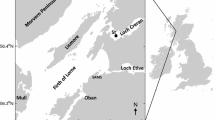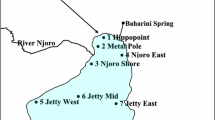Abstract
The ctenophore Mnemiopsis leidyi is an ecologically important predator in temperate coastal environments. Their populations fluctuate seasonally, serving as sinks of nutrients during periodic blooms, but as sources via excretion and during population collapse. Ctenophores were analyzed for elemental composition (C, N, and P) during 2008 and 2009 in Great South Bay, NY, USA. Salt-free weight percent C, N, and P correlated positively with ctenophore sizes and zooplankton prey abundances. Nitrogen and P were higher at the onset of blooms than during collapse when prey were substantially fewer. Ctenophores collected during average to high zooplankton densities had atomic ratios averaging C/N ~6:1 and C/P ~66:1, but became C- and P-depleted (C/N ~5:1, C/P ~128:1) with decreasing zooplankton. Incubations demonstrated rapid remineralization of ctenophore biomass (as NH4 +, HPO4 2−), following first order kinetics (e.g., k ~0.1–0.4 day−1) with enriched stoichiometric N and P fractionation relative to biomass under both oxic and anoxic conditions. Based on reported excretion rates, nutrient regeneration from excretion by active populations greatly exceeds nutrients remineralized during population crashes. To our knowledge, this is the first study documenting natural seasonal patterns in ctenophore elemental stoichiometry as a function of ctenophore size and prey availability.









Similar content being viewed by others
References
Anninsky, B.E., F.A. Finenko, G.I. Abolmasova, E.S. Hubareva, L.S. Svetlichny, L. Bat, and A.L. Kideys. 2005. Effect of starvation on the biochemical compositions and respiration rates of ctenophores Mnemiopsis leidyi and Beroe ovata in the Black Sea. Journal of the Marine Biological Association of the United Kingdom 85: 549–561.
Aspila, K.I., H. Agemian, and A.S.Y. Chau. 1976. A semi-automated method for the determination of inorganic, organic and total phosphate in sediment. Analyst 101: 187–197.
Burdige, D.J. 2006. Geochemistry of marine sediments. Princeton: Princeton University Press.
Condon, R.H., and D.K. Steinberg. 2008. Development, biological regulation, and fate of ctenophore blooms in the York River estuary, Chesapeake Bay. Marine Ecology Progress Series 369: 153–168.
Condon, R.H., D.K. Steinberg, and D.A. Bronk. 2010. Production of dissolved organic matter and inorganic nutrients by gelatinous zooplankton in the York River estuary, Chesapeake Bay. Journal of Plankton Research 32: 153–170.
Grill, E.V., and F.A. Richards. 1964. Nutrient regeneration from phytoplankton decomposing in seawater. Journal of Marine Research 22: 51–69.
Hall, O.J., and R.C. Aller. 1992. Rapid, small-volume, flow injection analysis for Σ CO2 and NH4 + in marine and freshwaters. Limnology and Oceanography 37(5): 1113–1119.
Kremer, P. 1975. Excretion and body composition of the ctenophore Mnemiopsis leidyi (A. Agassiz): comparisons and consequences. 10th European Symposium on Marine Biology, Ostend, Belgium (Sept 17–23) 2: 351–362.
Kremer, P. 1976. Population dynamics and ecological energetics of a pulsed zooplankton predator, the ctenophore Mnemiopsis leidyi. In Estuarine processes, ed. M.L. Wiley, 197–215. New York: Academic.
Kremer, P. 1977. Respiration and excretion by the ctenophore Mnemiopsis leidyi. Marine Biology 44: 43–50.
Kremer, P. 1982. Effect of food availability on the metabolism of the ctenophore Mnemiopsis mcraddyi. Marine Biology 71: 149–156.
Kremer, P., and M.R. Reeve. 1989. Growth dynamics of a ctenophore (Mnemiopsis) in relation to variable food supply. II. Carbon budgets and growth model. Journal of Plankton Research 11: 553–574.
Kremer, P., M.R. Reeve, and M.A. Syms. 1986. The nutritional ecology of the ctenophore Bolinopsis vitrea—comparisons with Mnemiopsis mccradyi from the same region. Journal of Plankton Research 8: 1197–1208.
Kristensen, E., and M. Holmer. 2001. Decomposition of plant materials in marine sediment exposed to different electron acceptors (O2, NO3 −, and SO4 2−), with emphasis on substrate origin, degradation kinetics, and the role of bioturbation. Geochimica et Cosmochimica Acta 65: 419–433.
Lee, C. 1992. Controls on organic carbon preservation: the use of stratified water bodies to compare intrinsic rates of decomposition in oxic and anoxic systems. Geochimica et Cosmochimica Acta 56: 3323–3335.
MacIsaac, J.J., and R.C. Dugdale. 1972. Interactions of light and inorganic nitrogen in controlling nitrogen uptake in the sea. Deep Sea Research 19: 209–218.
Middelburg, J.J., T. Vlug, and F. Vandernat. 1993. Organic-matter mineralization in marine systems. Global and Planetary Change 8: 47–58.
Nemazie, D.A., J.E. Purcell, and P.M. Gilbert. 1993. Ammonium excretion by gelatinous zooplankton and their contribution to the amount of ammonium requirements on microplankton in Chesapeake Bay. Marine Biology 116: 451–468.
Park, Y.C., and E.J. Carpenter. 1987. Ammonium regeneration and biomass of macrozooplankton and ctenophores in Great South Bay, New York. Estuaries 10(4): 316–320.
Pitt, K.A., D.T. Welsh, and R.H. Condon. 2009. Influence of jellyfish blooms on carbon, nitrogen and phosphorus cycling and plankton production. Hydrobiologia 616: 133–149.
Presley, B. J. 1971. Techniques for analyzing interstitial water samples. Appendix Part 1: determination of selected minor and major inorganic constituents. In Winterer, E. L., et al., Initial. Rep. Deep Sea Drilling Project, 7(2): 1749–1755. Washington, DC (U.S. Govt. Printing Office).
Purcell, J.E., and M.B. Decker. 2005. Effects of climate on relative predation by scyphomedusae and ctenophores on copepods in Chesapeake Bay during 1987–2000. Limnology and Oceanography 50: 376–387.
Reeve, M.R., M.A. Syms, and P. Kremer. 1989. Growth dynamics of a ctenophore (Mnemiopsis) in relation to variable food supply. I. Carbon biomass, feeding, egg production, growth and assimilation efficiency. Journal of Plankton Research 11: 535–552.
Schoo, K.L., N. Aberle, A.M. Malzahn, and M. Boersma. 2010. Does the nutrient stoichiometry of primary producers affect the secondary consumer Pleurobrachia pileus? Aquatic Ecology 44: 233–242.
Skopintsev, B.A. 1981. Decomposition of organic matter of plankton, humification, and hydrolysis. In Marine organic chemistry: evolution, composition, interactions, and chemistry of organic matter in sea water, ed. E.K. Duursma and R. Dawson, 125–177. New York: Elsevier.
Solorzano, L. 1969. Determination of ammonia in natural waters by the phenolhypochlorite method. Limnology and Oceanography 14(5): 799–801.
Strickland, J.D.H. and T.R. Parsons. 1968. A practical handbook of sea water analysis. Fisheries Research Board of Canada. Bulletin p. 167.
Sullivan, B.K., J.H. Costello, and D. Van Keuran. 2007. Seasonality of the copepods Acartia hudsonica and Acartia tonsa in Narragansett Bay, RI, USA during a period of climate change. Estuarine, Coastal and Shelf Science 73: 259–267.
Tinta, T., A. Malej, M. Kos, and V. Turk. 2010. Degradation of the Adriatic medusa Aurelia sp. by ambient bacteria. Hydrobiologia 645: 179–191.
Titelman, J., L. Riemann, T.A. Sornes, T. Nilsen, P. Griekspoor, and U. Bamstedt. 2006. Turnover of dead jellyfish: stimulation and retardation of microbial activity. Marine Ecology Progress Series 325: 43–58.
Von Brand, T., H.W. Rakestraw, and C.E. Renn. 1937. The experimental decomposition and regeneration of nitrogenous organic matter in sea water. The Biological Bulletin 72: 165–177.
West, E.J., D.T. Welsh, and K.A. Pitt. 2009. Influence of decomposing jellyfish on the sediment oxygen demand and nutrient dynamics. Jellyfish blooms: causes, consequences, and recent advances. Developments in Hydrobiology 206: 151–160.
Westrich, J.T., and R.A. Berner. 1984. The role of sedimentary organic matter in bacterial sulfate reduction: the G model tested. Limnology and Oceanography 29: 236–249.
Acknowledgments
Support for this study was provided by the New York State Division of Coastal Resources and the National Science Foundation (9ANT-0542111 to DJL and OCE-0726702 to JLC and OCE-0851207 to RCA). We thank J. Aspell, M. Deangelis, C. Heilbrun, J. Aller, A. Kaushik, Y. Liu, M. Murray, L. Schnal, C. Wall, and K. Zamborsky for their assistance in the field and laboratory. We also wish to thank P. Kremer for her constructive comments on this manuscript. This is contribution #1416 of the School of Marine and Atmospheric Sciences, Stony Brook University.
Author information
Authors and Affiliations
Corresponding author
Rights and permissions
About this article
Cite this article
McNamara, M.E., Lonsdale, D.J. & Aller, R.C. Elemental Composition of Mnemiopsis leidyi A. Agassiz 1865 and Its Implications for Nutrient Recycling in a Long Island Estuary. Estuaries and Coasts 36, 1253–1264 (2013). https://doi.org/10.1007/s12237-013-9636-x
Received:
Revised:
Accepted:
Published:
Issue Date:
DOI: https://doi.org/10.1007/s12237-013-9636-x




